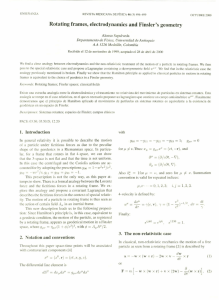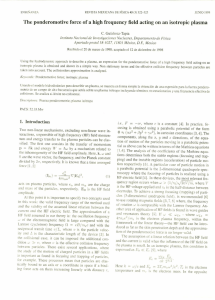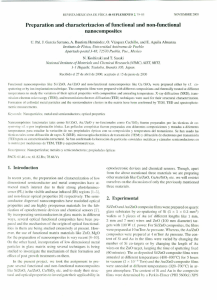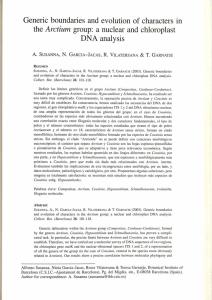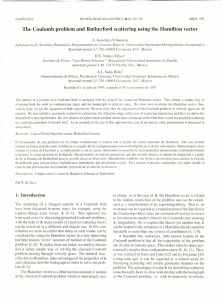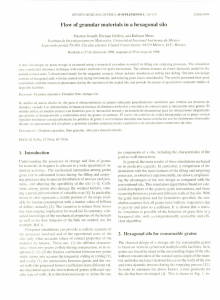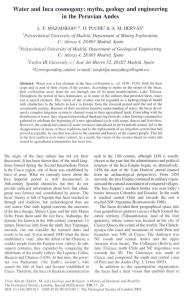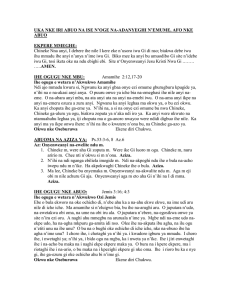The Feynman-Gell-Mann reduction via the method of adjoint operators
Anuncio
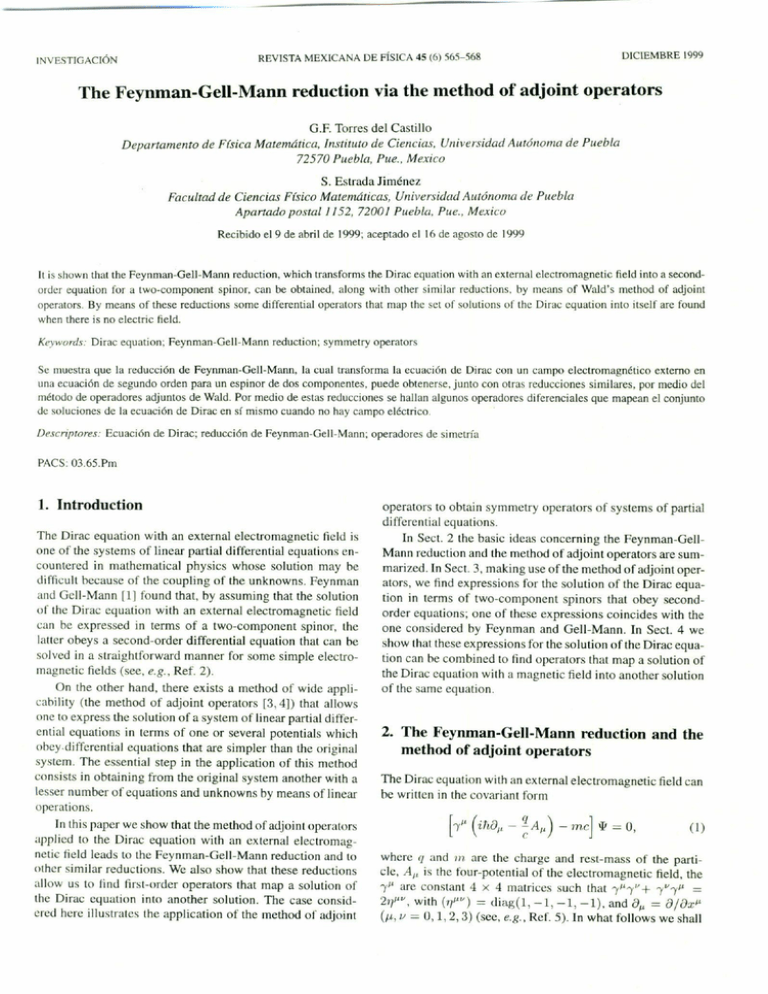
REVISTA MEXICANA DE FÍSICA 4S (6) 565-568
INVESTIGACiÓN
The Feynman-Gell-Mann
DICIEMBRE
1999
reduction via the method of adjoint operators
G.F. Torres del CasJillo
Departamento de Flsica Matemática. /nstillllO de Ciencias. Universidad Autónoma de Puebla
72570 Puebla, Pue.. Mexico
s. Estrada Jiménez
Facultad de Ciencias Físico Matemáticas, Universidad Alltónnma de Puebla
Apanado postal 1152, 72001 Puebla. Pue.. Mexic"
Recibido el9 de abril de 1999; aceptado el 16 de agosto de 1999
It is shown that the Fcynman-Gell-Mann rcduction, which transforms (he Dime equation with an external c1eclromagnetic field ioto a secondorder equalion fm a two-component spinor, can be obtained, along with other similar reductions. by rncans of Wald's rncthod of adjoint
operators. By meaos of lhese reductions sorne differential opcrators that map lhe set of solulions 01' (he Dime cquation into itself are found
whcn there is no electric field.
Kt'ywords: Dirac equation; Feynman-Gell.Mann
reduclion; symmetry operalors
Se muestra que la reducción de Feynman-Gell-Mann, la cual trunsforma la ecuación de Dirac con un campo electromagnético externo en
una ecuación de segundo orden para un espinar de dos componentes, puede obtenerse. junto con otras reducciones similares, por medio del
método de operadores adjuntos de Wald. Por medio de estas reducciones se hallan algunos operadores diferenciales que mapean el conjunto
de soluciones de la ecuación de Dirac en sí mismo cuando no hay campo eléctrico.
Descriptores: Ecuación de Dirac; reducción de Feynman.Gell-Mann;
operadores de simetría
PACS: 03.65.Pm
1. lntroduction
Thc Dirae equution with un external eleetromagnetic tIeld is
one of the systems of linear partial differential equations encountered in rnathernatical physics whose solution may he
difficult because of the coupling of the unknowns. Feynrnan
and Gell-Mann [1] found lhal, by assuming thallhe soJution
nf the Dirac equation wilh an external eleetrornagnctic field
can he cxpressed in terrns of a two-eornponcnt spinor, the
lalter obeys a sccond-order differential equation that can be
sol ved in a straightforward manner for sorne simple electromagnelic fields (see, e.g .• Ref. 2).
On the other hand, there exists a rnethod of wide applicabilily (the method 01' adjoinl operators [3,4]) lhal allows
<lnelo express the solution 01'a system of linear partial differential equations in terms of one or sevcral potentials which
nhey.differential equations that are simpler than the original
system. The essential stcp in the application of this method
consists in obtaining fmm the original system another with a
lesscr number 01'equations and unknowns by mean s of linear
opcrations.
In this paper wc show that the rncthod of adjoint opcralors
applicd to the Dimc cquation with an external e1ectromagnctic ficld leads to the Feynman-Gell-Mann reduction and lo
othcr similar rcductions. Wc also show that these rcductions
allow us lo lind first-ordcr opcrators that map a solution of
the Dime e4ualinn into another solution. The case eonsidcrcd hcrc iIlustralcs lhc application nI' thc method 01'adjnint
operalors lo ohlain symmelry operalors 01'syslems 01'partial
differential equations.
In Sect. 2 the basic ideas conecrning the Feynman-GellMann reduetion and the method of adjoint operators are summarized.ln Sec!. 3, making use oflhe melhod 01'adjoinl operators, we find expressions I'or the solulion of the Dirae equation in tcrms 01' two.component spinors that obcy seeond.
order cquations; one 01'these expressions coincides with the
one considered by Feynman and Gell-Mann. In Sec!. 4 we
show that thcse exprcssions for the solution of the Dirae equation can be combined lO find operators that mar a solution of
the Dirae cquation with a magnetie field into another solution
of the same cquation.
2. The Feynman-Gell-Mann reduction and the
method of adjoint operators
The Dirac equation with an cXlernal electmmagnetie
be written in the covarianl I'orm
field can
(1)
whcre fj and 111 are thc ehargc and rest.mass of the particJe, A¡J is ¡he four.potential of the eleetromagnetic ficld, the
lJI are constanl 4 x 4 matrices such that 111.')". + "('"
'),p. =
2,1"", wilh (1}''") = dia¡¡;(l, -1, -1, -1), and 8. = 8j8x.
(}', v = 0, 1,2,3) (see, e.g., ReL 5). In whal follows we shall
5óó
GF. TORRES DEL CASTILLO AND S ESTRADA JlMÉNEZ
=
clllploy rhe standard rcpresentation
')
0=
(1 O)
O
(...W)t
st At, whenever lhe composilion AS m.kes sense,
lhen fmm Eq. (8) il follows lhal
(1;)
-1
'
O
(2)
'
whcrc lhe (Ji are lhe Pauli matrices and 1 is lhe 2 x 2 unit
malrix.
Assuming that lhe solution of Eq. (t) can be exprcsscd as
(9)
Thcrefore, if
'!f' i~ a solution 01'
(lO)
=
\l,'hcrc <.p is a two-componcnl
[)" (iMJ" -
Eq. (9) implies Ihal {t(st(",,))
O, so lhal if { is selfadjoint, [t = E, 01' if tt is proportional lo £, one concludes
lhal st(",,) is a so[ulion oflhe original syslem (6).
In the next section we shall derive operalor identilies of
Ihe form (8), slarting from Ihe Dirac equalion and il will be
shown lhal Eq. (5) is a special case 01' Eq. ([O).
spinor ami using lhe faet Ihul
~A,;) - mc] [)v (iMJ ~Av) + H"]
= ,,''" (ihD" - ~A,,) (ihDv - ~Av)
v
f,,} (
e
2 2
-IIlC+-
-
<T'
.
-IU'
B
E
E)
-i<T'
(j
3. Potentials for tite sollltions of tite Dirac eqllation
.
B'
(4)
whefe E and B are lhe clcctric and magnctic fields corrcsponJing lo the four.potcnlial ...111, it follows that tp ohcys the
sccond~ordcrcquation fl,2j
f,,}
+~<T'
(B
]
+ iE) 'P = O.
(5)
Thus, any solution of Eq. (5) acls as a pOlcnlia~ for the solulion 01' lhe Dirac equalion given by Eq. (3) and, in Ihis manncr. the prohlem of solving El). (1) is transformed ¡nto lhe
prohlcm 01'solving Eq. (5) fOf a two-componcnl spinor.
Equatioll (3) is similar lo Ihe cxprcssions obtained by
mcans 01' lhe method uf adjoint operators, which yiclds lhe
solulion of a syslcm of parlial diffcrcntial equations in lerllls
01' pOlenlials 13.4]. [1'
{U)
=O
(6)
is a syslclll of linear partial differcntial equations, whcfe t is
linear parlial differential operalor Ihallllaps tensor Of spinor
liclds inlO lklds 01'lhe same type, and hy combining Iinearly
Eqs. (6) and thcir derivativcs one ohtains a ncw systcm with
a Icsscr nUlllhcr of cqualions and unknowns,
As poinled out in Ref. 4, the opcrator itqJ.l{)ll - me is seU.
adjoinl pmvided lhal lhe adjoinl 01' a linear partial differential operator, A, mapping four-componenl spinors into fourcomponent spinors, is the linear partial differenrial operaror,
A t , slIch lhal
'V''YnA~'
=
[At'~r')o'!'+ D,,8",
([ [)
for any pair 01' four-componenr spinors ep and 1.1', where •
denotes complex conjugalion, the superscript t denotes transposition and 8/1 is SOI11C
rom-vector. It may be nOliccd that if
one defines 4l
(1)*t'll. as in ReL 5, thcn Eq. (11) amounts
=-
lo
( 12)
Altcrnalivcly, ir one writes Ihe Dirae cquation with an external cleclromagnetic lidd in the form
( 13)
whcre
_ =- -8
if,
f
e
t.
-
'}
-t;J
e
+
(.Ihv
+ 'J)
-A
e
. o: -l3mc,
( 14)
i.llllllhe Dirac matrices are lakcn in Ihe usual way
;¡
(7)
thL'nIhL'rccxist linear opcrators 7 and S such that \'
<IlHllhc idcnlity
Sf
= 07
=
T(f)
a = (~
~)
([ 5)
(consistently wilh Eq. (2» t!len r is sclf-adjoint aecording to
Ihe usual dcllnitions cmployed in quantum I11echanics (which
makc, e.g., -irlv, n, li, a, self-adjoinl).ln olher words, ir,
in'lead 01' Eq. (1 1). one delines A I by
(1 ó)
(8)
holds.
Assllllling lhat the adjoilll, At, of any linear opcralOr A
is dctincd in such a way that At is also a linear operalor and
then t:f = £. Thc t1elinition (16) is morc convcnient than the
une givcn hy Eqs. (11) and (12) bccause il allows us lo make
use nI' se\'eral wcll.known results. In \vhal [01l0w5 il will be
:ISSlIIllCU
that lhe aujllints l)f lhe linear opcrators are givcn hy
lhe standard rules.
R('\~ Mex. F¡(l ,1_ 45 (6) (11Jl)l)
565-56X
TIlE FEYNMAN-GELL-MANN
REDUCfION
hcncc. if
Thc opcralor {; [Eq. (14)] can also bc writtcn as
{; =
-Yo
[-y" (ihD" - ~A") -
me] .
lhen '!'
is a lwo-component spinor sueh Ihat
= si (1/1) is a solution
(29)
of lhc Dirae cquation {;('!')
(!1/1) ,
+ me] (!1/1)
O. In a morc cxplicit formo sincc -YoT.,'1/1
means 01" the opcrator
(i"D" -
R;: [-y"
~A,,) +
me]
-Yo.
(18)
Indccd,
il3)
A
A
=
R{;
( iS
( 19)
A ;: ,¡"v (ihD" -
~A,.)
(ihDv
2 2
- m e
Tu}
+
hq
(30)
1/1
obcys
= O.
(31)
- ~Av)
f~l(7
.
(B
+ iE)]
1/1
Equations (30) and (31) eoineidc with Eqs. (3) and (5), rcD,
spcctivcly.
Suhtraction of Eqs. (23) givcs
(20)
which map (wo-componenl
spinors ¡nlo two-cornponenl
e
+
_m2e2
E.
--(7'
(if¡av
(32)
where
spinors and are self-adjoinl
(33)
SI = S.
By cxprcssing
0, in (he form
(21 )
(he solution 01' the Dirae equation £('1')
and
=
HCIlCC,
Rf('¡")
and vare two-component
= O alllounts lo
spinors, the c4ualioll
!l
Au
+ Wu =
O,
~I~I)
( = " - v = (~ ~
we obtain the
'!' ;: 72('!').
S2f = 0272,
identity
(22)
whcrc
=
=
is a solution of thc Dirac cquation (1) providcd lhal
Eq. (29), ¡.e., (A - iS)(1/1) = O oro equivalcnlly,
- ~Av)
-O"
e
(ihD" - ~A")
'!' = [-y"
['¡"v (if'D" - ~A,,)
[scc Eq. (4)], whcrc A and S are lhe linear operalors
b;:
1/1
01 (1/1) = o,
(17)
Two syslcms of cqualions of Ihc form (7) can bc oblained by
•
567
VIA TIlE METIIOD OF ADJOINT OPERATORS
(34)
whcrc
S2;: 72R
(35)
and, thcrcforc,
Oi=A+iS.
iSIl
+ Av = o.
SJ = [,
(23)
Adding Eqs. (23) onc finds lhat
1
(ihDII
'
-
Thus, if ~~ is a two-component
(2~)
~AI') + me] loT¿t.
(36)
spinor such that
Oi(1/1)
=
O,
(37)
¡.e.,
whcrc
o, ;:A + iS
(25)
(iha" - ~A,,) (if,,)v - ~A,,)
[,/"V
and
.)"].
-m-e
y=u+v=
1
O
(O
1
(26)
Tí 'R£ = GIlí,
[ef Eq. (8)] wilh
Thus, we havc the opcrator il!enlily
can hc wrillen as S, t
S, ;: IjR = ~-Yo-Yo
= O, ~
[-y"
(iMJ,.
Sinec -Yo. A. B ami -Yoh"(ifID,.
adjoinl [scc Eq. (17)] and T,t
=
- ~A,.)
+ me]
which
-Yo. (27)
- (q/e)A,.) + lile] arc selfT.,', the adjoinls 01' O, and
SI are givcn hy
01
--
si =
¡he fOllr-component
'!'
= si (1/1)
=
fu/
+ -(7
e
.
b" (¡hD,. -
(iflO" - ~A,.)
[-y"
systcl11s of Iwo cqualions
¡hal wilh any cquation
-y"T.,',
(28)
(38)
+ 711 e] (~)
(39)
that can be derivcd
fmm Eq. (1) and
of this typc one ohtains an expression
ror lhe solutions 01' lhe Dirae c,!uation (scc ¡¡Iso SCCl.4). As
Icnlials
+ lile]
= O,
1/1
is a SOIUliollof the Dirac equation ( 1) [ef E,!s. (31) and (30) j.
It should he clcar lhal Eqs. (24) and (32) arc notlhc only
01" a systCJ11of partial
~A,,)
]
(B - iE)
spinor
we show in the next section,
A - l'L'"J,
.
the expressions
diffcrcntial
is Bol only a convcnient
cqualions,
hUI
al so
nf the syslem (sce
Rel'. Mex. Fío,. ~5 (6) (1999) 565-568
cqualions
ror Ihe solutions
in tcrms 01' po-
way of solving
may be lIscful to find internal
al so
Refs. 3,6
and 7).
lhe system of
symmclries
----
568
---------
O.E TORRES DEL CASTILLO AND S. ESTRADA JIMÉNEZ
4. Symmetry operators
\Vhen lhe eleetrie f¡cld is ahsent. the operator B is equal lo
lero Isee Eq. (20)J and 01 = 01 Isee Eqs. (25) and (28)J;
hence. ir '11 is a solulion 01' lhe Dirae equation. according lo
Eq. (2-1). \
'T,('¡') satisl;es 01(,)
O and, allhe same
time. O~C\) :::= O, which mean s 1hal \Ve can take ~, :::= .\ as lhe
solulion 01' Eq. (29) and lherefore,'¡'
51(,)
SI1i(w)
is aiso a solulion 01' lhe Dirac cquation. It can he secn lhal
T/ T¡ = 1 + whcrc -}!i :::= i).O,L..,..2,3. thus \Ve concludc
thallhc tirsl-ordcr diffcrcntial opcrator
=
=
=
=
,f.,
51 TI =
[1"
(ihD,. - ~A,,) + me]
10(1
+ 15)
[1"
(¡hD" - ~A,,) + me]
10(1-15)
(41)
also maps solulions of lhe Dirae equation with a given magIlctic ¡¡cid ¡nlo solulions 01' the sarne equalion. lt may be
noticcd Ihat 1'01" cm)' clcctrornagnctic field.
= 0:2 and
lhcreforc sI7i and sl1i map solUlions of Ihe Dirac equation (1) into solulions 01' the same equation; however, since
10T/Ti = T,'Ti = 1 - 15 and 10Ti1i = T.,'1i = 1 + 15,
taking iOlo accouot the fact thal ')'5 aoticornrnutes with ')"',
one tinds that the ellect 01' 72 and sl1i on a solUlion 01'
Eq. (1) is equivalent to a multiplicalion by 2m.c.
In the case where E = O. one can easily derive an inflnity
01' equations 01' lhe form (7). Sinee H = O [see Eq. (20)], from
Eqs. (23) wc I;nd lhal, for any pair 01' eomplex eonstants,'\, It,
vI
sI
A('\"
+ ¡LV)
whieh is 01' lhe form (7) with O
T(w), with
.
T=
(,\O
O
(42)
= O,
=
¡t
A and ,
=
'\11
+ ¡LV
O)
=
(43)
,\ O l'
It! Eqs. (26) and (3-1)1 and lherdore TR[ = 07. Thus,
it follows thal if lb is a two-componclll spinor such thal
01 (¡j')
O, ¡.C'" A( ¡j')
O, whieh Is just Eq. (31) or (38)
with E
O, then RtTI(Ij;) is a solution ofthe Dirae equalion. Funhcnnorc. ir '1' is a solulion of the Dirac equation
=
=
=
1. R.P. Fcynmall ami M. Gcll-Malln, P!l.vs.
Rl'l'.
109 (1958) 193.
2. O.L. de Langc and R.E. Raab, Operatar MetllOds i" QUGlltWIl
Ml'c/Illllin-, (Oxford University Press. Oxford, 1991) Sect. 11.4.
is also a
(44)
rnaps solutions of lhe Dirac cqualion with a given rnagnelic
field into solutions 01' lhe same equation.INole that Eqs. (-10)
and (41) are speeial cases 01' Eq. (44).J Moreover. the same
conclusion holds ir in the cornposilion 'R)rtr. lhe lwo operalors 7 are oflhe form (43). with different pairs of constants.
In this manner. olle concludes that
bI)
(-10)
maps solutions 01' lhe Dirae cquation with a given magnctic
flcld inlo solUliolls 01'lhe same cquation.
In an cntircly similar manncr. ir E :::= 0, lhen o~ :::= O2
anJ il follows lhat Ihe opcrator
SiTi =
with an arhitrary (slalie) magnelie field, RITtT(w)
solution of the same equalion. Thus
(45)
dI
also maps solulions 01'thc Dirac equation with a given magIlclic ¡¡cid into solutions 01'lhe same equalion. for any set 01'
complcx conslanls a, b, e, d.
For any system 01' linear partial differenlial equations
sueh lhat 01 = O, the eomposition SIT maps lhe set 01'
solulions 01'Ihe system 01'equations ioto itself. An additional
cxamplc is provided by lhe source-free Maxwell equations
for which two decoupled cqualions can be obtained with
O = \7' = 01 17J.
5. Concluding remarks
As we have shown. the melhod 01' adjoint operators allows
us lo f1nd systemalically cxpressions for the solutions 01'lhe
Dirae equation in tcrms 01' spinor pOlentials. This rnethod
can he also applied with other fields or when the haekground
spacctime is nol naI. Among lhe by-products of this approaeh
is lhe finding 01"operators that map Ihe sel of solutions 01'the
original problcm inlo itself.
The symmclry operators found in SCCl.4 do not dcpeod
un lhe symmcIl"ics 01"the rnagnelie field; apart from the condition that lhe cleclric ficld be equal to zero in sorne inertial
frame, thel"e are no further restrietions on the rnagnctic field.
Ir E . II
o ano B:2 - E:2 > O. lhen Ihere exisls un incrtial
frame where lhe electric field vanishes and the results of the
preccding seclion apply.
Thc examples menlioned hcre show that the rnethod of
adjoinl operalors is not only useful lo sirnplify the solution
01'systems 01'linear purtial differential equations. but in sorne
cases il can also be used lO tind internal syrnrnctries.
=
5. lD. Bjorken ami S.D. Drell. Re/a/iI'istic
(McGraw-Hill, New York, 1964).
Quantum
Mec!lllllics,
G. G.F. Torres del Castillo. Prot'. Roy. Soc. Landan A 400 (t985)
I IlJ.
3 R.M. Wald, /'lIy.,. Rev. UII. 41 (1978) 203.
4. G.F. Torres del Castillo. Rell. Mex. Fí.<;.38 (1992) 192.
7. G,F. Torres del Castillo, Rel'. Mex. Fís. 3S (1989) 282.
Rev. Me:<. Fín s. 45 (6) (1999) 565-568
